Green Line "A" Branch
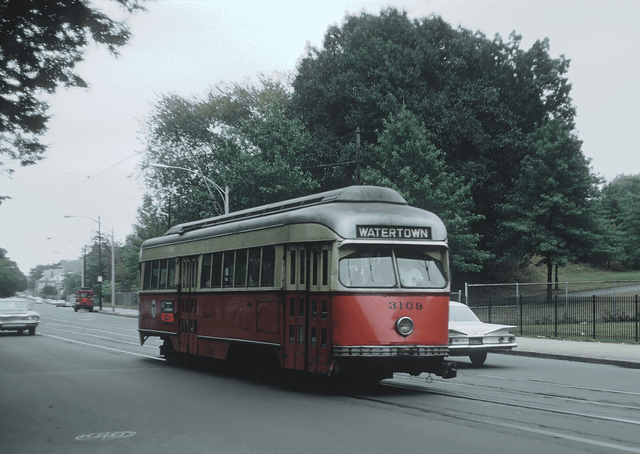
Green Line "A" Branch

| Green Line "A" Branch | |||||||||||||||||||||||||||||||||||||||||||||||||||||||||||||||||||||||||||||||||||||||||||||||||||||||||||||||||||||||||||||||||||||||||||||||||||||||||||||||||||||||||||||||||||||||||||||||||||||||||||||||||||||||||||||||||||||||||||||||||||||||||||||
|---|---|---|---|---|---|---|---|---|---|---|---|---|---|---|---|---|---|---|---|---|---|---|---|---|---|---|---|---|---|---|---|---|---|---|---|---|---|---|---|---|---|---|---|---|---|---|---|---|---|---|---|---|---|---|---|---|---|---|---|---|---|---|---|---|---|---|---|---|---|---|---|---|---|---|---|---|---|---|---|---|---|---|---|---|---|---|---|---|---|---|---|---|---|---|---|---|---|---|---|---|---|---|---|---|---|---|---|---|---|---|---|---|---|---|---|---|---|---|---|---|---|---|---|---|---|---|---|---|---|---|---|---|---|---|---|---|---|---|---|---|---|---|---|---|---|---|---|---|---|---|---|---|---|---|---|---|---|---|---|---|---|---|---|---|---|---|---|---|---|---|---|---|---|---|---|---|---|---|---|---|---|---|---|---|---|---|---|---|---|---|---|---|---|---|---|---|---|---|---|---|---|---|---|---|---|---|---|---|---|---|---|---|---|---|---|---|---|---|---|---|---|---|---|---|---|---|---|---|---|---|---|---|---|---|---|---|---|---|---|---|---|---|---|---|---|---|---|---|---|---|---|---|---|
| Overview | |||||||||||||||||||||||||||||||||||||||||||||||||||||||||||||||||||||||||||||||||||||||||||||||||||||||||||||||||||||||||||||||||||||||||||||||||||||||||||||||||||||||||||||||||||||||||||||||||||||||||||||||||||||||||||||||||||||||||||||||||||||||||||||
| Type | Light rail | ||||||||||||||||||||||||||||||||||||||||||||||||||||||||||||||||||||||||||||||||||||||||||||||||||||||||||||||||||||||||||||||||||||||||||||||||||||||||||||||||||||||||||||||||||||||||||||||||||||||||||||||||||||||||||||||||||||||||||||||||||||||||||||
| System | Green Line | ||||||||||||||||||||||||||||||||||||||||||||||||||||||||||||||||||||||||||||||||||||||||||||||||||||||||||||||||||||||||||||||||||||||||||||||||||||||||||||||||||||||||||||||||||||||||||||||||||||||||||||||||||||||||||||||||||||||||||||||||||||||||||||
| Status | closed and abandoned | ||||||||||||||||||||||||||||||||||||||||||||||||||||||||||||||||||||||||||||||||||||||||||||||||||||||||||||||||||||||||||||||||||||||||||||||||||||||||||||||||||||||||||||||||||||||||||||||||||||||||||||||||||||||||||||||||||||||||||||||||||||||||||||
| Locale | Boston and Watertown | ||||||||||||||||||||||||||||||||||||||||||||||||||||||||||||||||||||||||||||||||||||||||||||||||||||||||||||||||||||||||||||||||||||||||||||||||||||||||||||||||||||||||||||||||||||||||||||||||||||||||||||||||||||||||||||||||||||||||||||||||||||||||||||
| Termini | Park Street station, Boston Watertown Yard | ||||||||||||||||||||||||||||||||||||||||||||||||||||||||||||||||||||||||||||||||||||||||||||||||||||||||||||||||||||||||||||||||||||||||||||||||||||||||||||||||||||||||||||||||||||||||||||||||||||||||||||||||||||||||||||||||||||||||||||||||||||||||||||
| Operation | |||||||||||||||||||||||||||||||||||||||||||||||||||||||||||||||||||||||||||||||||||||||||||||||||||||||||||||||||||||||||||||||||||||||||||||||||||||||||||||||||||||||||||||||||||||||||||||||||||||||||||||||||||||||||||||||||||||||||||||||||||||||||||||
| Opened | 1856 (first sections, as part of Cambridge Horse Railroad) 1889 (electrification on route from Oak Square to Boston)[1] | ||||||||||||||||||||||||||||||||||||||||||||||||||||||||||||||||||||||||||||||||||||||||||||||||||||||||||||||||||||||||||||||||||||||||||||||||||||||||||||||||||||||||||||||||||||||||||||||||||||||||||||||||||||||||||||||||||||||||||||||||||||||||||||
| Closed | June 20, 1969 | ||||||||||||||||||||||||||||||||||||||||||||||||||||||||||||||||||||||||||||||||||||||||||||||||||||||||||||||||||||||||||||||||||||||||||||||||||||||||||||||||||||||||||||||||||||||||||||||||||||||||||||||||||||||||||||||||||||||||||||||||||||||||||||
| Operator(s) | Various private companies, then M.T.A., then MBTA | ||||||||||||||||||||||||||||||||||||||||||||||||||||||||||||||||||||||||||||||||||||||||||||||||||||||||||||||||||||||||||||||||||||||||||||||||||||||||||||||||||||||||||||||||||||||||||||||||||||||||||||||||||||||||||||||||||||||||||||||||||||||||||||
| Character | Underground from Park Street to Kenmore, central median from Kenmore to Packards Corner, street-running from Packards Corner to Watertown Yard | ||||||||||||||||||||||||||||||||||||||||||||||||||||||||||||||||||||||||||||||||||||||||||||||||||||||||||||||||||||||||||||||||||||||||||||||||||||||||||||||||||||||||||||||||||||||||||||||||||||||||||||||||||||||||||||||||||||||||||||||||||||||||||||
| Rolling stock | PCC streetcars (1941-1969) | ||||||||||||||||||||||||||||||||||||||||||||||||||||||||||||||||||||||||||||||||||||||||||||||||||||||||||||||||||||||||||||||||||||||||||||||||||||||||||||||||||||||||||||||||||||||||||||||||||||||||||||||||||||||||||||||||||||||||||||||||||||||||||||
| Technical | |||||||||||||||||||||||||||||||||||||||||||||||||||||||||||||||||||||||||||||||||||||||||||||||||||||||||||||||||||||||||||||||||||||||||||||||||||||||||||||||||||||||||||||||||||||||||||||||||||||||||||||||||||||||||||||||||||||||||||||||||||||||||||||
| Number of tracks | 2 | ||||||||||||||||||||||||||||||||||||||||||||||||||||||||||||||||||||||||||||||||||||||||||||||||||||||||||||||||||||||||||||||||||||||||||||||||||||||||||||||||||||||||||||||||||||||||||||||||||||||||||||||||||||||||||||||||||||||||||||||||||||||||||||
| Track gauge | 4 ft 81⁄2 in(1,435 mm) | ||||||||||||||||||||||||||||||||||||||||||||||||||||||||||||||||||||||||||||||||||||||||||||||||||||||||||||||||||||||||||||||||||||||||||||||||||||||||||||||||||||||||||||||||||||||||||||||||||||||||||||||||||||||||||||||||||||||||||||||||||||||||||||
Route map | |||||||||||||||||||||||||||||||||||||||||||||||||||||||||||||||||||||||||||||||||||||||||||||||||||||||||||||||||||||||||||||||||||||||||||||||||||||||||||||||||||||||||||||||||||||||||||||||||||||||||||||||||||||||||||||||||||||||||||||||||||||||||||||
| |||||||||||||||||||||||||||||||||||||||||||||||||||||||||||||||||||||||||||||||||||||||||||||||||||||||||||||||||||||||||||||||||||||||||||||||||||||||||||||||||||||||||||||||||||||||||||||||||||||||||||||||||||||||||||||||||||||||||||||||||||||||||||||
The "A" Branch or Watertown Branch was a streetcar line in the Boston, Massachusetts area, operating as a branch of the Massachusetts Bay Transportation Authority Green Line. In 1969 it was replaced by the 57 bus, though the tracks remained continuous until March 1994.
| Green Line "A" Branch | |||||||||||||||||||||||||||||||||||||||||||||||||||||||||||||||||||||||||||||||||||||||||||||||||||||||||||||||||||||||||||||||||||||||||||||||||||||||||||||||||||||||||||||||||||||||||||||||||||||||||||||||||||||||||||||||||||||||||||||||||||||||||||||
|---|---|---|---|---|---|---|---|---|---|---|---|---|---|---|---|---|---|---|---|---|---|---|---|---|---|---|---|---|---|---|---|---|---|---|---|---|---|---|---|---|---|---|---|---|---|---|---|---|---|---|---|---|---|---|---|---|---|---|---|---|---|---|---|---|---|---|---|---|---|---|---|---|---|---|---|---|---|---|---|---|---|---|---|---|---|---|---|---|---|---|---|---|---|---|---|---|---|---|---|---|---|---|---|---|---|---|---|---|---|---|---|---|---|---|---|---|---|---|---|---|---|---|---|---|---|---|---|---|---|---|---|---|---|---|---|---|---|---|---|---|---|---|---|---|---|---|---|---|---|---|---|---|---|---|---|---|---|---|---|---|---|---|---|---|---|---|---|---|---|---|---|---|---|---|---|---|---|---|---|---|---|---|---|---|---|---|---|---|---|---|---|---|---|---|---|---|---|---|---|---|---|---|---|---|---|---|---|---|---|---|---|---|---|---|---|---|---|---|---|---|---|---|---|---|---|---|---|---|---|---|---|---|---|---|---|---|---|---|---|---|---|---|---|---|---|---|---|---|---|---|---|---|---|
| Overview | |||||||||||||||||||||||||||||||||||||||||||||||||||||||||||||||||||||||||||||||||||||||||||||||||||||||||||||||||||||||||||||||||||||||||||||||||||||||||||||||||||||||||||||||||||||||||||||||||||||||||||||||||||||||||||||||||||||||||||||||||||||||||||||
| Type | Light rail | ||||||||||||||||||||||||||||||||||||||||||||||||||||||||||||||||||||||||||||||||||||||||||||||||||||||||||||||||||||||||||||||||||||||||||||||||||||||||||||||||||||||||||||||||||||||||||||||||||||||||||||||||||||||||||||||||||||||||||||||||||||||||||||
| System | Green Line | ||||||||||||||||||||||||||||||||||||||||||||||||||||||||||||||||||||||||||||||||||||||||||||||||||||||||||||||||||||||||||||||||||||||||||||||||||||||||||||||||||||||||||||||||||||||||||||||||||||||||||||||||||||||||||||||||||||||||||||||||||||||||||||
| Status | closed and abandoned | ||||||||||||||||||||||||||||||||||||||||||||||||||||||||||||||||||||||||||||||||||||||||||||||||||||||||||||||||||||||||||||||||||||||||||||||||||||||||||||||||||||||||||||||||||||||||||||||||||||||||||||||||||||||||||||||||||||||||||||||||||||||||||||
| Locale | Boston and Watertown | ||||||||||||||||||||||||||||||||||||||||||||||||||||||||||||||||||||||||||||||||||||||||||||||||||||||||||||||||||||||||||||||||||||||||||||||||||||||||||||||||||||||||||||||||||||||||||||||||||||||||||||||||||||||||||||||||||||||||||||||||||||||||||||
| Termini | Park Street station, Boston Watertown Yard | ||||||||||||||||||||||||||||||||||||||||||||||||||||||||||||||||||||||||||||||||||||||||||||||||||||||||||||||||||||||||||||||||||||||||||||||||||||||||||||||||||||||||||||||||||||||||||||||||||||||||||||||||||||||||||||||||||||||||||||||||||||||||||||
| Operation | |||||||||||||||||||||||||||||||||||||||||||||||||||||||||||||||||||||||||||||||||||||||||||||||||||||||||||||||||||||||||||||||||||||||||||||||||||||||||||||||||||||||||||||||||||||||||||||||||||||||||||||||||||||||||||||||||||||||||||||||||||||||||||||
| Opened | 1856 (first sections, as part of Cambridge Horse Railroad) 1889 (electrification on route from Oak Square to Boston)[1] | ||||||||||||||||||||||||||||||||||||||||||||||||||||||||||||||||||||||||||||||||||||||||||||||||||||||||||||||||||||||||||||||||||||||||||||||||||||||||||||||||||||||||||||||||||||||||||||||||||||||||||||||||||||||||||||||||||||||||||||||||||||||||||||
| Closed | June 20, 1969 | ||||||||||||||||||||||||||||||||||||||||||||||||||||||||||||||||||||||||||||||||||||||||||||||||||||||||||||||||||||||||||||||||||||||||||||||||||||||||||||||||||||||||||||||||||||||||||||||||||||||||||||||||||||||||||||||||||||||||||||||||||||||||||||
| Operator(s) | Various private companies, then M.T.A., then MBTA | ||||||||||||||||||||||||||||||||||||||||||||||||||||||||||||||||||||||||||||||||||||||||||||||||||||||||||||||||||||||||||||||||||||||||||||||||||||||||||||||||||||||||||||||||||||||||||||||||||||||||||||||||||||||||||||||||||||||||||||||||||||||||||||
| Character | Underground from Park Street to Kenmore, central median from Kenmore to Packards Corner, street-running from Packards Corner to Watertown Yard | ||||||||||||||||||||||||||||||||||||||||||||||||||||||||||||||||||||||||||||||||||||||||||||||||||||||||||||||||||||||||||||||||||||||||||||||||||||||||||||||||||||||||||||||||||||||||||||||||||||||||||||||||||||||||||||||||||||||||||||||||||||||||||||
| Rolling stock | PCC streetcars (1941-1969) | ||||||||||||||||||||||||||||||||||||||||||||||||||||||||||||||||||||||||||||||||||||||||||||||||||||||||||||||||||||||||||||||||||||||||||||||||||||||||||||||||||||||||||||||||||||||||||||||||||||||||||||||||||||||||||||||||||||||||||||||||||||||||||||
| Technical | |||||||||||||||||||||||||||||||||||||||||||||||||||||||||||||||||||||||||||||||||||||||||||||||||||||||||||||||||||||||||||||||||||||||||||||||||||||||||||||||||||||||||||||||||||||||||||||||||||||||||||||||||||||||||||||||||||||||||||||||||||||||||||||
| Number of tracks | 2 | ||||||||||||||||||||||||||||||||||||||||||||||||||||||||||||||||||||||||||||||||||||||||||||||||||||||||||||||||||||||||||||||||||||||||||||||||||||||||||||||||||||||||||||||||||||||||||||||||||||||||||||||||||||||||||||||||||||||||||||||||||||||||||||
| Track gauge | 4 ft 81⁄2 in(1,435 mm) | ||||||||||||||||||||||||||||||||||||||||||||||||||||||||||||||||||||||||||||||||||||||||||||||||||||||||||||||||||||||||||||||||||||||||||||||||||||||||||||||||||||||||||||||||||||||||||||||||||||||||||||||||||||||||||||||||||||||||||||||||||||||||||||
Route map | |||||||||||||||||||||||||||||||||||||||||||||||||||||||||||||||||||||||||||||||||||||||||||||||||||||||||||||||||||||||||||||||||||||||||||||||||||||||||||||||||||||||||||||||||||||||||||||||||||||||||||||||||||||||||||||||||||||||||||||||||||||||||||||
| |||||||||||||||||||||||||||||||||||||||||||||||||||||||||||||||||||||||||||||||||||||||||||||||||||||||||||||||||||||||||||||||||||||||||||||||||||||||||||||||||||||||||||||||||||||||||||||||||||||||||||||||||||||||||||||||||||||||||||||||||||||||||||||
History
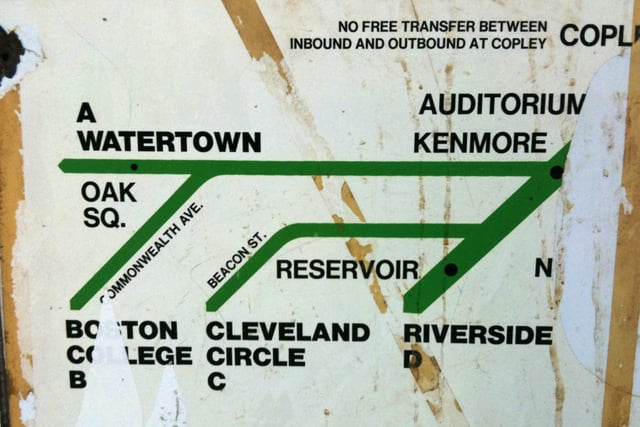
1967 map of branches of the newly named Green Line, showing the "A" Branch

1916 map showing the loop at Braves Field
The line started as a horse car street railway, as a branch of the Cambridge Horse Railroad. The branch split at Central Square, Cambridge, and crossed the Charles River on the River Street Bridge into Allston. It continued on through Union Square, and in 1858 was opened to Oak Square in the center of Brighton. The part east of Union Square later became part of the 64 bus route.
The first electric trolleys in Boston ran between the Allston Carhouse (northeast of Union Square) and Park Square downtown, on tracks running south on Harvard Street, east on Beacon Street, south on Massachusetts Avenue, and east on Boylston Street. These first ran on January 1, 1889, on tracks that had been built for horse cars.
On June 13, 1896, tracks opened from Union Square east along North Beacon Street and Commonwealth Avenue to Kenmore Square, merging with the existing tracks on Beacon Street. That year, the western terminal was also extended to just shy of Newton Corner, with Newton Corner service beginning May 21, 1898. On December 9, 1912, the route was extended north to Watertown on tracks that had been used by routes from Cambridge to Newton Corner since 1900. During the early part of the 20th century, the line was also used for light rail freight service.[1]
Cars on the line began using the Tremont Street Subway to turn around at Park Street November 8, 1897, via the Boylston Street Incline at the Public Garden. The Boylston Street Subway was opened to an incline in Kenmore Square on October 3, 1914, and the jog on Massachusetts Avenue was eliminated. The Blandford Street Portal, on Commonwealth Avenue west of Kenmore, opened October 23, 1932, marking the last change in the route of the service. In 1941, the line became the first line in Boston to have primary service with the new PCC streetcars, which replaced the Types 4 and 5 cars then in service.[1]
Prior to 1967, when the current letters were assigned to the Green Line's branches, the Watertown Line was the 69 Watertown-Park Street route. The 57, the line's current number, was actually assigned to Heath Street short-turn trips on the "E" Branch. The line was assigned the letter "A" because it was the northernmost branch. Turnback loops existed at Union Square (via Cambridge Street and Harvard Avenue) and Oak Square, as well as the Watertown terminal. Additionally, from 1915 to January 15, 1962, a loop existed at Boston University, which until 1953 was the site of Braves Field, for special events along the part of the line concurrent with the "B" Branch.[2]
Closure
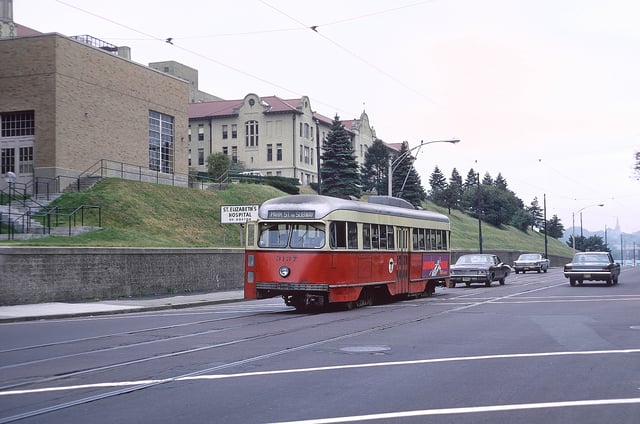
The "A" Branch ran in mixed traffic for much of its length, causing it to be slow and unreliable.
The opening of the Green Line "D" Branch (Riverside Branch) in 1959 caused streetcar lines in Cambridge running out of Harvard Square to be converted to trackless trolley, and the newly freed PCC streetcars were reassigned to the Riverside Branch. However, the 1940s-era PCC fleet was aging, and maintaining five different types of PCCs complicated mechanical work.[3] By the late 1960s, wear and tear and a lack of replacements caused a shortage of Green Line streetcars, and the MBTA announced the closure of the A branch on a "trial" basis.[3][4]
The "A" Branch was chosen for closure because much of its route consisted of street running sections from Watertown to Packards Corner, and in 1964 there had been objections to keeping the service past Newton Corner.[1] Streetcars last ran on June 20, 1969, with the 57 bus route beginning the next day.
Track removal
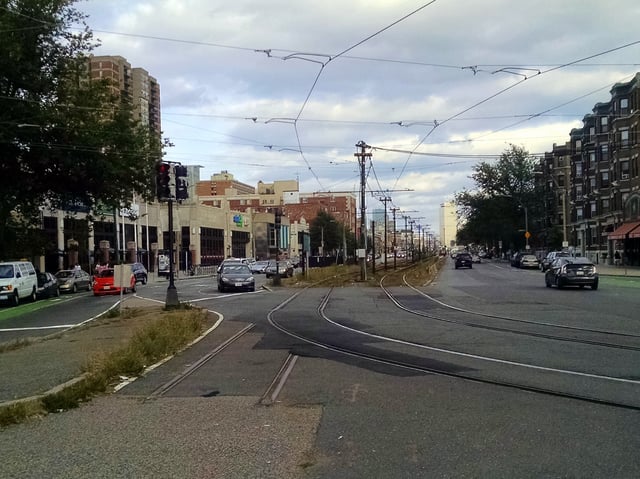
Stub remains of "A" Branch tracks at Packards Corner. The switch was disconnected in 2014.
The legacy tracks remained after 1969, being used for several decades to allow Green Line streetcars to reach the Watertown Carhouse for maintenance. The last use of the line was in 1993, when the fleet of PCC streetcars used for the Ashmont-Mattapan High Speed Line was refurbished at the Watertown carhouse.[1] The electrified overhead wire was finally removed in March 1994.[2]
Additional overhead infrastructure, as well as the tracks themselves, were mainly removed by the end of the summer of 1996 as part of a resurfacing project on North Beacon Street. Remnants of the tracks are still visible today in the Watertown Yard bus terminal (no longer used for railcar maintenance), as well as a short stub track at Packard's Corner, where the "A" branch used to diverge from the "B" branch. The stub, part of the former outbound track, was used for temporarily storing disabled trains until it was shorted to just a few feet long in the mid 2000s; the switch was not disconnected until 2014.
Restoration of the "A" branch was advocated to provide a one-seat ride to downtown Boston from the northern corridor (rather than requiring a transfer at Kenmore), but was ruled too costly and less safe compared to the replacement bus service.[4]
Bustitution
Route 57
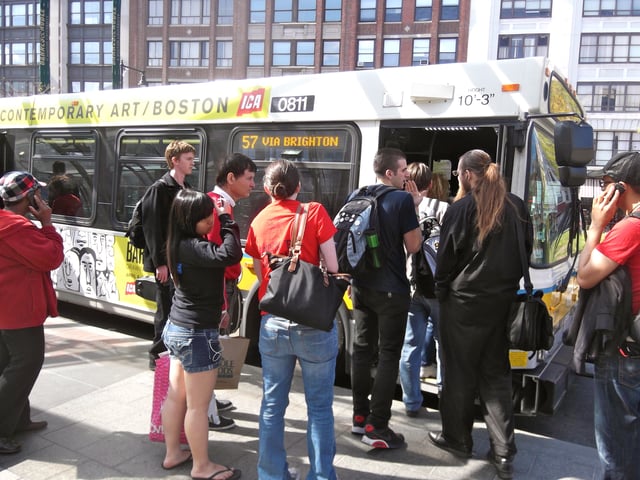
Passengers board a route 57 bus at Kenmore
The 57 Watertown-Kenmore via Newton and Brighton bus was initiated in 1969 as replacement service for the "A" Branch. The 57 follows the same routing from Watertown Yard to Kenmore except for the Newton Corner rotary, where inbound buses follow traffic rather than operating in a counterflow lane as streetcars had.
As a way to make the service more attractive, the MBTA originally had the 57 operate as a limited (boarding-only outbound and dropoff-only inbound) between Packards Corner and Kenmore, with the "B" Branch providing local service along Commonwealth Avenue. In December 2006 the 57 began making local stops on Commonwealth.[2]
Since free transfers had been previously eliminated by the M.T.A. in October 1961, Watertown riders had to pay a double fare to continue downtown after the bustitution. This continued until January 1, 2007, when a new fare structure added free transfers when using a CharlieCard.[5]
Additional short turn trips between Oak Square and Kenmore at rush hour were cut in June 1971, and restored for mornings only in 1987. Morning-only Brighton Center - Kenmore trips were operated from September 1999 to June 2013.[2] On September 1, 2008, due to overcrowding on the inner part of the route, the MBTA began operating the 57A Oak Square - Kenmore Station via Commonwealth Avenue short turn of the 57 during weekday rush hours in September 2008.[2][6][7] Approximately every other trip operates as a 57A during rush hours; during off-peak hours and weekends all buses run the full-length route.[2]
Route 57 operates as a busy key bus route, with headways between 10 and 12 minutes at all times (and equal headways on the 57A during peaks). As of 2012, the 57 and 57A combined were ninth-busiest route on the MBTA system, with 10,094 boardings on an average weekday.[8] Route 57 is based at the Albany Street Bus Facility during weekday rush hours and midday service, and is based at the Cabot Garage for evening, weekend, and holiday service.[8]
One early-morning trip, intended for MBTA employees but open to the public, continues to Haymarket on Mondays through Saturdays as 193 Watertown - Haymarket via Kenmore. It was inaugurated along with several other routes by the M.T.A. in September 1960, though they were not listed in public timetables until September 1999.[2]
Express buses

A route 501 bus in Brighton Center in 2016
The portion of the route west of Brighton Center is also served by four express routes operate to downtown Boston and Copley Square:
501 Brighton Center - Downtown via Oak Square & Massachusetts Turnpike
502 Watertown Yard - Copley Square (St. James Avenue at Dartmouth St.) via Newton Corner & Massachusetts Turnpike
503 Brighton Center - Copley Square via Oak Square & Massachusetts Turnpike
504 Watertown/Newton Corner - Downtown via Massachusetts Turnpike
The 501 and 503 serve the same local streets but the 501 operates to downtown Boston and the 503 to Copley Square; the 502 and 504 operate similarly. All four routes enter the Massachusetts Turnpike at the Newton Corner rotary.
Express bus service from Brighton and Watertown began even while the "A" Branch was still running. The 61 Watertown/Newton Corner-Downtown Boston via Mass. Turnpike route began in July 1967, with Saturday service added in March 1968. In December 1967, the 61 was renumbered as 4, and a new route 61 running from Oak Square to downtown via Brighton Center and Union Square, Boston and the Turnpike was initiated.[2] In September 1968, the 61 was changed to originate at Brighton Center, from where it ran through Oak Square and entered the Turnpike at Newton Corner. Route 62 Watertown-Copley was started at the same time.[2]
In June 1970, the routes were renumbered from 4, 61, and 62 to 304, 301, and 302 to reflect their express routings. (The 300-series numbers had been used by ex-Eastern Massachusetts Street Railway bus routes in Lawrence, briefly under MBTA control, in 1968).[2] In March 1974, route 301 buses operating opposite the peak direction began using the pre-1968 routing on Cambridge Street. Inbound morning buses reverted to the Newton Corner routing in June 1974, but outbound afternoon buses continued to travel via Union Square. Some afternoon buses switched back to the Cambridge Street route in September 1976 and September 1978.[2]
All three routes had a number of minor changes to their downtown and Copley Square routings in the late 1970s and 1980s. Midday and Saturday service on the 302 began in January 1983; in December 1989, the midday and Saturday buses added a Copley Square stop as route 304 Watertown-Downtown via Copley.[2] In September 1996, three routes were renumbered as the 501, 502, and 504.[2]
In January 2005, the 503 Brighton Center-Copley Sq. route was inaugurated. Inbound afternoon trips began operating via Cambridge Street in March 2014.[2]